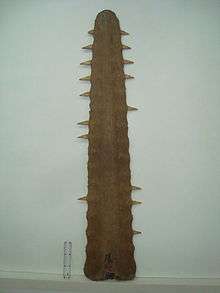Large-tooth sawfish
| Large-tooth sawfish | |
|---|---|
 | |
| Not recognized (IUCN 3.1) | |
| Scientific classification | |
| Kingdom: | Animalia |
| Phylum: | Chordata |
| Class: | Chondrichthyes |
| Subclass: | Elasmobranchii |
| Order: | Pristiformes |
| Family: | Pristidae |
| Genus: | Pristis |
| Species: | P. perotteti |
| Binomial name | |
| Pristis perotteti J. P. Müller & Henle, 1841 | |
The large-tooth sawfish, Pristis perotteti, is a sawfish of the family Pristidae, found in tropical and subtropical parts of the Atlantic and east Pacific, but possibly now extirpated from most of the east Atlantic.[1] As its relatives, it also enters freshwater, and there are records as far inland as Santarém and Lake Nicaragua. It reaches a length of up to 6.5 metres (21 ft), and the maximum published weight is 591 kilograms (1,303 lb).[2] Recent evidence strongly suggests P. microdon is synonymous with P. pristis.[3] Consequently, the IUCN removed P. perotteti from their list, instead recognizing it as part of the critically endangered P. pristis.[4]
Taxonomy
Considerable taxonomic confusion has surrounded this species. It is part of the Pristis pristis species complex, which also includes P. microdon. P. microdon has sometimes been considered synonymous with P. perotteti, and uncertainty exists over what species the scientific name P. microdon really belong to (its original description lacked a type locality). Additionally, the east Pacific population traditionally included in P. perotteti may represent a separate species.[1]
Recent evidence strongly suggests the three are conspecific (in which case P. microdon and P. perotteti are synonyms of P. pristis), as morphological and genetic differences are lacking.[3] Three main clades based on NADH-2 genes were evident (Atlantic, Indo-West Pacific, and East Pacific), but these do not match the distributions claimed for P. pristis (circumtropical), P. microdon (Indo-West Pacific) and P. perotteti (Atlantic and East Pacific) respectively.[3]
Ecology
The large-tooth sawfish inhabits sandy or muddy bottoms of shallow coastal waters, estuaries, river mouths and freshwater rivers and lakes. It is usually found in turbid channels of large rivers over soft mud bottoms, occurring in large rivers and estuaries, with adults usually being found in estuaries and young ascending into fresh water. Large adults can also be found in fresh water. It feeds on benthic animals and small schooling species. The saw is used for grubbing and attacking prey as well as for defense.

Conservation
Incidental commercial catch has likely been the most significant factor in the decline of sawfish populations in U.S. waters. Sawfish are extremely vulnerable to overexploitation due to their entanglement in net gear, restricted habitat, and their low intrinsic rate of increase. Habitat degradation also likely impacts the species given their inshore distribution.
The largetooth sawfish is listed as a U.S. National Marine Fisheries Service (NMFS) Species of Concern.[5] Species of Concern are those species about which the U.S. Government’s National Oceanic and Atmospheric Administration, National Marine Fisheries Service, has some concerns regarding status and threats, but for which insufficient information is available to indicate a need to list the species under the U.S. Endangered Species Act.
The WildEarth Guardians petitioned[6] NMFS to list the largetooth sawfish under the ESA in April 2009. On July 29, 2009 NMFS issued a positive 90-day finding[7] that listing the species under the ESA may be warranted. This finding initiates a one-year status review process before an ESA listing might be proposed.
Status reviews
In 2000, NMFS denied a petition to list the largetooth sawfish as threatened or endangered under the Endangered Species Act (65 FR 12959; March 10, 2000) because there was insufficient information presented in the petition and in NMFS files to indicate that a listing might be warranted.
References
- 1 2 Charvet-Almeida, P.; Faria, V.; Furtado, M.; Cook, S.F.; Compagno L.J.V. & Oetinger, M.I. (2006). "Pristis perotteti". IUCN Red List of Threatened Species. Version 2008. International Union for Conservation of Nature. Retrieved 19 October 2009.
- ↑ Froese, Rainer and Pauly, Daniel, eds. (2006). "Pristis perotteti" in FishBase. May 2006 version.
- 1 2 3 Faria, V. V.; McDavitt, M. T.; Charvet, P.; Wiley, T. R.; Simpfendorfer, C. A.; Naylor, G. J. P. (2013). Species delineation and global population structure of Critically Endangered sawfishes (Pristidae). Zoological Journal of the Linnean Society 167: 136–164. doi:10.1111/j.1096-3642.2012.00872.x Retrieved 26 August 2013.
- ↑ Kyne, P.M.; Carlson, J. & Smith, K. (2013). "Pristis pristis". IUCN Red List of Threatened Species. Version 2014.3. International Union for Conservation of Nature. Retrieved 2 June 2015.
- ↑ Species of Concern.
- ↑ http://www.wildearthguardians.org/Portals/0/support_docs/petition-largetooth-sawfish-4-21-09.pdf
- ↑ http://www.nmfs.noaa.gov/pr/pdfs/fr/fr74-37671.pdf